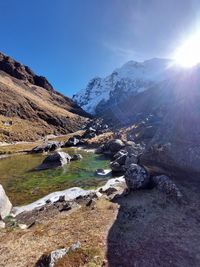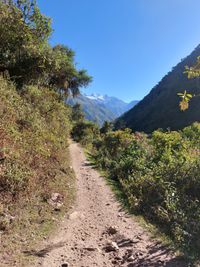Salkantay Trek
A 4 or 5-day trek ending at Machu Picchu. This challenging trek takes you over the Salkantay Pass at 4580 meters. The route and surroundings are incredibly diverse; one moment you're walking alongside frozen lakes surrounded by snow-capped peaks, and an hour later you're walking along a roaring river in the jungle.
The trek can be done with or without a guide, but my advice is to do it organized. This saves a lot of planning and is very enjoyable! Organized treks often start and end in Cusco.
Number of days: 4-5 days
Starting point: Cusco, Peru
Ending point: Cusco, Peru
Difficulty: Challenging
Characteristic: Highly varied environment and ending at Machu Picchu
Big variety of environments and views
The trek offers a variety of environments and views, including mountain peaks, alpine lakes, jungle, and ruins. With a guide, you'll learn a lot about the Incas and their fascinating history and culture.
Machu Picchu and the Salkantay Pass
The highlight is, of course, Machu Picchu on the last day, but the trek over the Salkantay Pass, surrounded by snow-capped peaks, is also breathtaking!
Altitude sickness on the first and second day
The trek is certainly challenging, with significant elevation gain at high altitude. However, anyone who is physically fit should be able to complete it. One of the biggest obstacles is altitude sickness. Read this blog about altitude sickness and how to prevent. The second day over the Salkantay Pass is by far the toughest. It is possible to ride a horse to the top of this pass. You'll be dropped off at the top and only need to descend to your campsite. If you're part of a group tour, the guides will closely monitor your health and fitness. They'll advise whether you're fit enough to hike the pass or if you should take the horse instead.
Tip: book an organized hike
You can do the trek organized with a guide or hike it independently. The advantage of an organized trek is having a guide, good accommodation, safety, meals, and porters. Additionally, the guide will handle all the permits and tickets for Machu Picchu. If you have to arrange this yourself, it can be a huge puzzle. There are many different tour operators offering the trek, each with their own variations. Different overnight stays, activities, and transportation. We booked our trek with Salkantaytrekking.com and had an excellent experience. It was a bit on the expensive side, but it was well worth it! We had very kind guides, delicious meals, nice accommodations, and everything was very well organized, with close attention paid to our well-being.
Dry season
Cusco's dry season runs from April to October, with June, July, and August being the driest months. These are also the busiest months. However, the trek is possible year-round.
Organized trips leave from Cusco
Cusco is a 1.5-hour flight from the capital city Lima. The downside is that you fly directly from sea level to 3400 meters, so your body doesn't have time to acclimate to the altitude. The risk of altitude sickness is much higher, so plan to spend a few extra days in Cusco to acclimatize.
Alternatively, you can take a bus from Lima to Cusco via other interesting places in Peru. This way, you gradually ascend to higher altitudes and acclimatize better.
Day program 4-day trek
Day 1: Cusco → Soraypampa
Early in the morning (read: 4 am), you'll be picked up from your hotel and driven for 4 hours to the start of the trek. The trek truly begins in Mollepata, where you'll walk for 3 hours to the first overnight stop, Soraypampa. Here, you can relax for a bit and then walk to Humantay Lake at 4200 meters in the afternoon. By the time you reach the lake, all the day tourists have gone, making it much quieter. At the same time, the guides assess whether you're fit enough at this altitude to climb the pass the next day.
Day 2: Soraypampa → Collapampa
Today is the toughest day. You start early and hike for 4 hours to the top of the Salkantay Pass at 4630 meters. It's possible to do this on horseback if you struggled on the first day. From the pass, it's all downhill, but still a long way. In 6 hours, you'll hike to Collapampa through the jungle. The contrast today is huge; you start among snowy mountains with frozen streams, and halfway through the day, you'll need to apply plenty of insect repellent against the jungle bugs.
Day 3: Collapampa → Aguas Calientes
You'll walk through avocado and passion fruit plantations to a coffee plantation, where you'll receive an explanation. Then, you'll take a van to Hidroelectrica, from where you'll walk for 3 hours along the train tracks to Aguas Calientes. Along the way, you'll catch your first glimpse of Machu Picchu.
Day 4: Aguas Calientes → Machu Picchu → Cusco
The big day; visiting Machu Picchu. Rise early to be one of the first to enter. After the tour of Machu Picchu, you can relax in Aguas Calientes before taking the train to Ollantaytambo. This is a stunning train journey. From Ollantaytambo, you'll be taken back to Cusco by bus.
.jpg/picture-200?_=18deec15c50)

